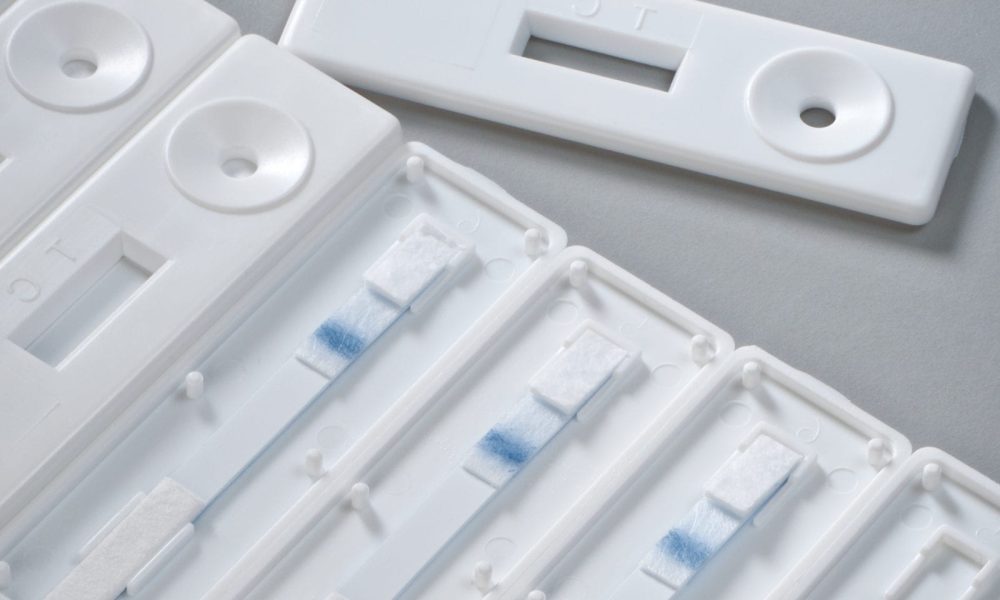Innovation in Signal Generation: Labels

How Are Labels Used In Lateral Flow Tests?
Key Considerations In Label Choice
Recent Innovations In Labels
Manufacturability and Scalability
Key Take-Away
Lateral Flow Market 2.0 Series: Part 4
In the final instalment of this series on innovations in self-testing driving us towards Lateral Flow Market 2.0, our CEO, Chris Yates highlights the increasing range of labels used within lateral flow tests to drive improved performance.
How Are Labels Used In Lateral Flow Tests?
A signal generator, or ‘label’, is the means by which the result of a lateral flow test is read – either visually, or by a smartphone app or reader. The label will be bound to an antibody or other binding moiety, which in turn is bound to an analyte and produces a readable signal on the lateral flow device membrane. Labels can be derived from colloidal gold , carbon, latex particles, or fluorescence substances or particles.
As an example, for a sandwich assay when a sample is applied to a lateral flow test it flows through a filter pad and through a conjugate release pad containing the labelled binder, then along the nitrocellulose strip. If the sample contains the target biomarker, it will form a complex with an antibody conjugated to a label, such as gold or carbon, and result in the formation of a coloured line – pink/red for gold labels, or black for carbon labels, for example – by binding of the complex to test line. This process would, in this sandwich assay example, indicate a positive result for the target analyte. So in essence the label is a signal reagent that is used to indicate the result, whether it’s positive or negative, which can be visually interpreted or read with a reader or smartphone. The concentration of an analyte in a particular sample would be indicated proportionally to the amount of signal at the test line (for a sandwich assay) or in inverse proportion for a competitive assay.
Key Considerations In Label Choice
The decision as to which label to use as a signal reagent depends on a number of factors:
- Whether the test is to be read visually
- If the test is intended to be used with a lateral flow device reader
- If the test is to multiplexed and needs a clear differentiation between lines
- If the aim is to enhance test sensitivity requirements
- If the focus is ease of scaling up for manufacturing
For visually-read assays the detection particle must be large enough to be seen, but not so large as to overwhelm the antibody (or antigen) conjugated to its surface through steric hindrance.
Gold particles are typically between 20-100nm in diameter, but there are always exceptions. Gold, coloured latex and carbon are commonly used for visual assays. Gold nanoparticles are popular due to their high affinity for antibody binding, relatively low antibody usage, and good stability in optimised assays. A variety of sizes are available and gold can be read visually, but is also compatible with most reflectance, absorbance and camera-system lateral flow test readers, including smartphones. In addition to passive conjugation, gold particles can be bound to binder molecules such as antibodies via covalent linkage, including via ‘click-chemistry’ methods some of which are available as conjugation kits.
Latex is flexible as both covalent coupling and passive conjugation methods are possible and it is increasingly available in a wide variety of colours. This multi-coloured option lends itself as a good choice for visual multiplexing. Latex is available in a range of sizes (100nm – 300nm plus) and can be manufactured in large volumes; also, the required antibody coating concentration for conjugates can be higher than gold but, overall, costs can be similar.

Fluorescent lateral flow assay labels are becoming increasingly popular and a large range are commercially available. Fluorescence can offer advantages in sensitivity, and higher-end quantitative and multiplexed assays. Fluorescent assays are dependent on reader systems for device interpretation as there is no visual signal.
A more recent choice for a label is carbon. Carbon nanoparticle assays are easy to interpret and carbon is a relatively cheap option. The use of carbon as a label is likely to increase in popularity, especially in cost-sensitive applications.
Overall, when selecting the optimal label, it should be detectable at low concentrations, easy to conjugate, and should retain stability following conjugation.
Recent Innovations In Labels
As highlighted in our previous article, we have seen an expansion of the use of different labels outside of traditional colloid gold, to improve sensitivity for example of lateral flow tests. Below we highlight a couple of areas of innovation:
- Fluorescence and Time-Resolved Fluorescence: recent publications illustrate the increased use of fluorescence labels and the use of time-resolved fluorescence to improve the sensitivity of lateral flow strips. One such example(1) has been used to improve the performance of a saliva test for Helicobacter pylori where concentrations of pylori in saliva are extremely low and require enhanced sensitivity.
- Gold Nano ‘Shapes’: gold particles that are not traditional spheres. These include gold nanorods that have been elongated to resemble rods through to gold nanopopcorn(2) (no, that’s not a typo) and these have been shown to be more sensitive than traditional gold spheres.
- Magnetic Nanoparticles: a number of Abingdon Health’s scientific team pioneered the use of magnetic particles in collaboration with Phillips Healthcare in the 2000s; and magnetic particles are attractive as they can improve the speed to result. A recent study(3) reviewed the use of magnetic biosensors across a range of applications, highlighting their advantages “for enhancing sensitivity and reducing the detection time of conventional immunoassays due to their unique properties including magnetic behavior, high surface area, excellent stability, and easy biocompatibility”.
Manufacturability and Scalability
An issue we see often is challenges of scalability in the conjugation process. As an experienced contract development and manufacturing organization, (CDMO) this is something we consider at the early stages of any development process. We do not want to approach design freeze without establishing how reproducible and scalable – and stable – the conjugation process will be in routine manufacture.
Careful consideration of this is essential and a few things to look out for include:
- The batch size of the label you are looking to use. Are there any limitations to scale in the production of this material?
- Can larger batches of the label be made and then stored for use across multiple batches, thus cutting out the need for multiple QC testing events?
- Is the conjugation process mapped out and is it a procedure that can be applied to increasingly larger batches?
The Key Takeaway
The key message is to seek advice early when it comes to lateral flow assay labels and conjugation. Each potential label choice comes with its own set of advantages and disadvantages. Label choice needs to be fully aligned with the specification of the lateral flow assay being developed, the required user-experience and the manufacturing process.
Abingdon Health has significant experience of developing and scaling to routine, large-scale manufacture of assays with a wide variety of labels, either for qualitative or quantitative applications and can offer this objective expertise as part of your contract development project.
Sources:
- A time-resolved fluorescent microsphere-lateral flow immunoassay strip assay with image visual analysis for quantitative detection of Helicobacter pylori in saliva – PubMed (nih.gov)
- Hierarchical Nanogold Labels to Improve the Sensitivity of Lateral Flow Immunoassay – PMC (nih.gov)
- Recent Developments in Innovative Magnetic Nanoparticles-Based Immunoassays: From Improvement of Conventional Immunoassays to Diagnosis of COVID-19 | SpringerLink

